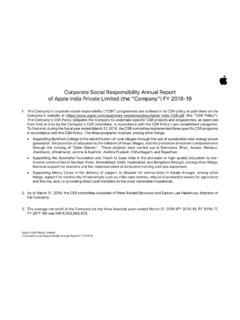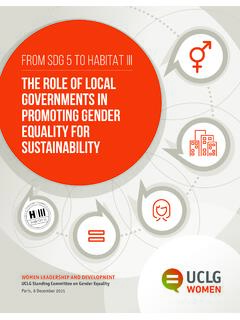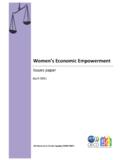Transcription of Effects of Female Education on Economic Growth: A Cross ...
1 ISSN 1303-0485 eISSN 2148-7561 DOI 2015 EDAM Sciences: Theory & Practice 2015 April 15(2) 349-357 Received | 24 December 2014 Accepted | 11 February 2015 OnlineFirst | 10 April 2015a Corresponding author Assist. Prof. Hakan Oztunc (PhD), Department of Economics, Fatih University, Buyukcekmece, Istanbul 34500 Turkey Research areas: Applied econometrics, evaluation research methodology, educational policies Email: b Zar Chi Oo, Department of Economics, Fatih University, Buyukcekmece, Istanbul 34500 Turkey Email: Prof. Zehra Vildan Serin (PhD), Department of Economics, Fatih University, Buyukcekmece, Istanbul 34500 Turkey Email: study examines the extent to which women s Education affects long-term Economic growth in the Asia Pacific region. It focuses on the time period between 1990 and 2010, using data collected in randomly selected Asia Pacific countries: Bangladesh, Cambodia, China, India, Indonesia, Lao PDR, Malaysia, Myanmar, Philippines, Thailand, and Vietnam.
2 In addition, it emphasizes the impact of Female Education on Economic growth as measured by GDP, literacy, fertility, and the Female labor force. Using panel regression analysis, it is found that the fertility rate, Female labor force participation rate and Female primary school enrollment are significant factors for annual per capita income : Female Education Economic growth Asia Pacific region Fertility rate Female labor force participation rate Panel data Random Effects modelHakan OztuncaFatih UniversityZar Chi OobFatih UniversityZehra Vildan SerincFatih UniversityEffects of Female Education on Economic Growth: A Cross Country Empirical StudyEducational Sciences: Theory & Practice350 More than half of the world s population lives in the Asia Pacific region. Many of them face extreme poverty, as close to half of them earn less than a dollar per day. This region has a high primary school enrollment ratio and literacy rates, despite the lack of gender equality in Education .
3 In addition, it is difficult to find labor participation rates for both women and men. With regard to Education , the gender gap is very strong in the Asia Pacific region, particularly at the secondary or high school level. For example, courses such as nutrition, nursing, and teacher training are dominated by girls while boys would select engineering, law, agriculture, and technology courses. In the Philippines, for example, more than 90 percent of Female students are enrolled in Female -dominated courses. Poverty is analyzed through many factors including per capita income, distribution of assets and income, quality of government, its policies, and institutions related to Education , health and other aspects of human development. The poor living in rural and urban areas face different issues. While the rural poor have limited access to Education and health care, the urban poor depend on cash for survival as they are unable to grow their own food unlike their rural counterparts.
4 It is also difficult for the urban poor to find good jobs due to the lack of higher Education . This study explores the relationship between women s Education and Economic growth in the Asia Pacific region, which faces major problems in the level of Economic development, school enrollment as well as gender discrimination in enrollment (Asia-Pacific Forum for Environment and Development [APFED], 2000). The Asia Pacific region is divided into five sub regions: South Asia, Southeast Asia, Northeast Asia, Central Asia, and the Pacific. From these sub regions, several countries have been selected for analysis in this study. These include Bangladesh, Cambodia, China, India, Indonesia, Lao PDR, Malaysia, Myanmar, Philippines, Thailand, and Vietnam. Myanmar is the poorest among these countries as well as in the Southeast Asian sub region: 20% of Myanmar s citizens are below the national poverty line.
5 Compared to other countries in the Asia Pacific region, Myanmar also has the highest infant mortality rate, and more than 20% of children from poor families do not attend ReviewThere are two very basic reasons for examining a link between Education and Economic growth. First, at a general level, living standards have risen tremendously. Education is now necessary for people to benefit from scientific advancement as well as to contribute to it. Second, at a more specific level, a wide range of econometric studies indicates that the income levels that individuals can command depend on their level of Education . If people who are educated earn more than those who are not, shouldn t the same be true of countries? The level of output per hour worked in a country, if not the rate of change of output per hour worked, ought to depend on the population s educational attainment.
6 If spending on Education delivers returns of some sort, in much the same way as spending on fixed capital does, then it is sensible to talk of investing in human capital as the counterpart to investing in fixed capital. Hence, the process of Education can be analyzed as an investment decision. The effect of formal and informal Education on farmers efficiency and income levels has long been analyzed in economics literature. Hussain and Byerlee (1995) highlighted that returns for schooling in agriculture may be as high as for urban wage earners. Lockheed, Jamison, and Lau (1980) indicated a positive effect of Education on output, and though the results were mixed, they noted that a significant positive relationship was more likely to be found in areas where farmers are modernizing. Phillips (1994) found that the average increase in output was due to an additional four years of schooling, while Appleton and Balihuta (1996) indicated that Education was not found to be significant.
7 Mirotchie (1994) investigated technical efficiency in cereal crop production in Ethiopia using aggregate data for the 1980 86 period. He reported that primary schooling tends to increase productivity, while secondary schooling has no effect. Weale (1992) found positive and significant returns for additional years of formal schooling in terms of increased output of cereal crops. Serin, Bayyurt, and Civan (2009) discovered a positive link between Education and farmers incomes in are also studies on the role of gender equality and women s empowerment in reducing poverty and stimulating Economic growth. Morrison, Raju, & Sinha (2007) proved that the impact of women s rights and decision-making power in families helped reduce poverty and improve productivity at per person and family levels. In addition, they showed the relationship between gender equality and poverty reduction and Economic growth at the macro level.
8 Zpolat and Y ld r m (2009) investigated the relationship between the Education of women and Economic growth by analyzing the Economic dimension of women s Education . She expressed that it Oztunc, Chi Oo, Serin / Effects of Female Education on Economic Growth: A Cross Country Empirical Study351has been long concluded that Education of women has a positive effect on Economic growth in all societies especially in developing countries, and called for more attention on women s Education . She also explained that the net returns on Education and training of women are greater than that for men. Schultz (1961) who was the first economist, studied the difference in worker productivity by gender , based on their work experience and schooling. Becker and Thomes (1994) also indicated that different wages among workers was in line with the difference in their Education level, training, and work experience. Bourguignon and Morrison (2002) examined how higher Education levels lead to lower fertility rates by affecting per capita income growth and decreasing mortality rate per child.
9 Barro (1991) revealed that more educated households are likely to have higher productivity than more children; this shows that Education and fertility rate have a negative effect on each other. Barro (1991) also said that the Economic growth rate is related to changes in human capital and schooling years. Baden and Green (1994) however argued that women s Education is not the main factor for improved child health and welfare and reduced fertility, and that it is more effective to spend directly on child health and family planning to reduce fertility and child mortality instead of investing in educating women . Dollar and Gatti (1999) also studied the relationship between gender inequality in Education and Economic growth. They explained the positive relationship between the Education of women and Economic growth by using a five-year growth interval and by controlling for possible endogeneity among Education and Economic growth with the help of instrumental variable estimation.
10 Klasen and Lamanna (2008) also investigated the impact of gender inequality in Education and employment on Economic growth in developing countries through a 41-year period (1960 2000). He revealed that gender inequality in Education and employment can reduce Economic growth, and also stated that reducing gender inequality would lead to Economic development because the Education of women has a huge impact on fertility and the creation of human capital for the next and Gatti (1999) found a negative link between the gender gap in Education and Economic growth, in contrast to Barro s (1999) view that there is a positive relationship between the two. This prompted Klasen (2008) to avoid using the same methods as the previous researchers, to discover why they found differing relationships between gender gap in Education and Economic growth. Klasen (2008) showed very close links between gender inequality in labor force participation and employment, and also found that decreasing marginal returns on Education means that the Education of women is limited to the lower level.













